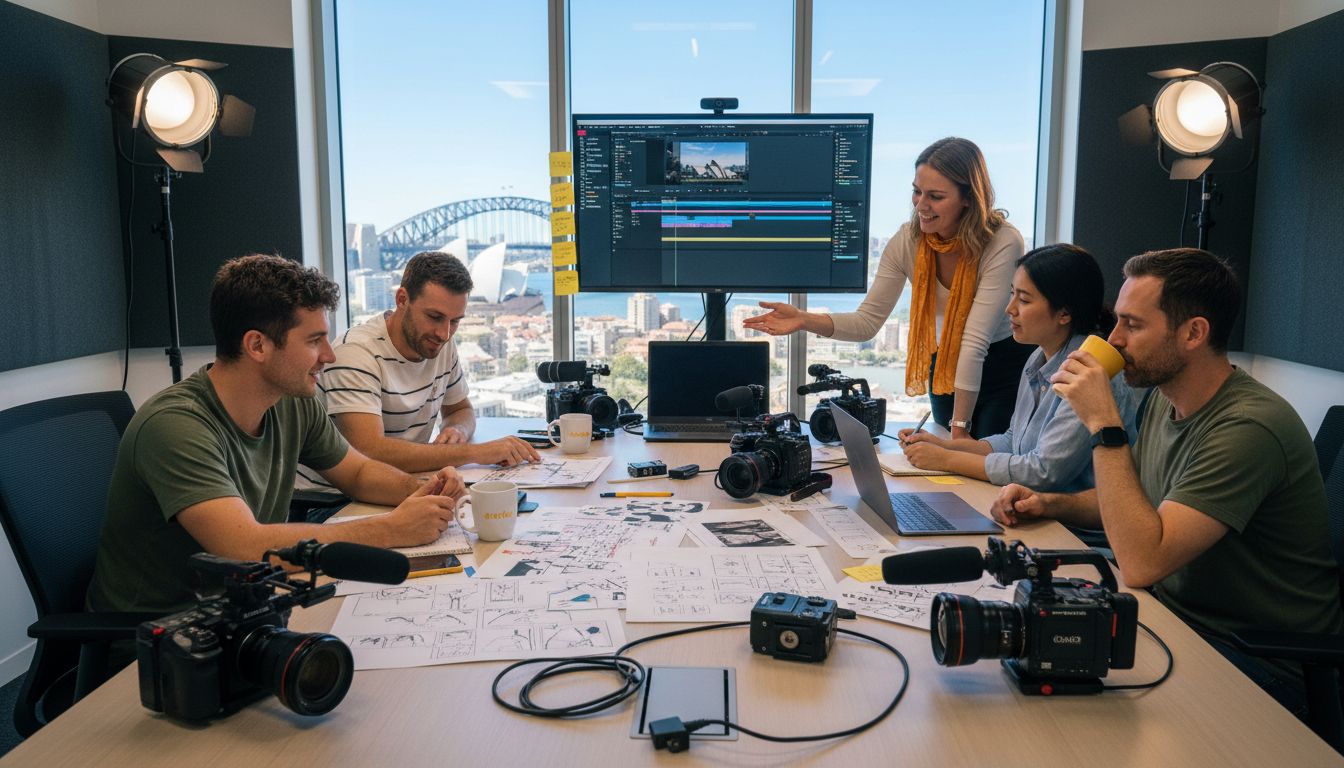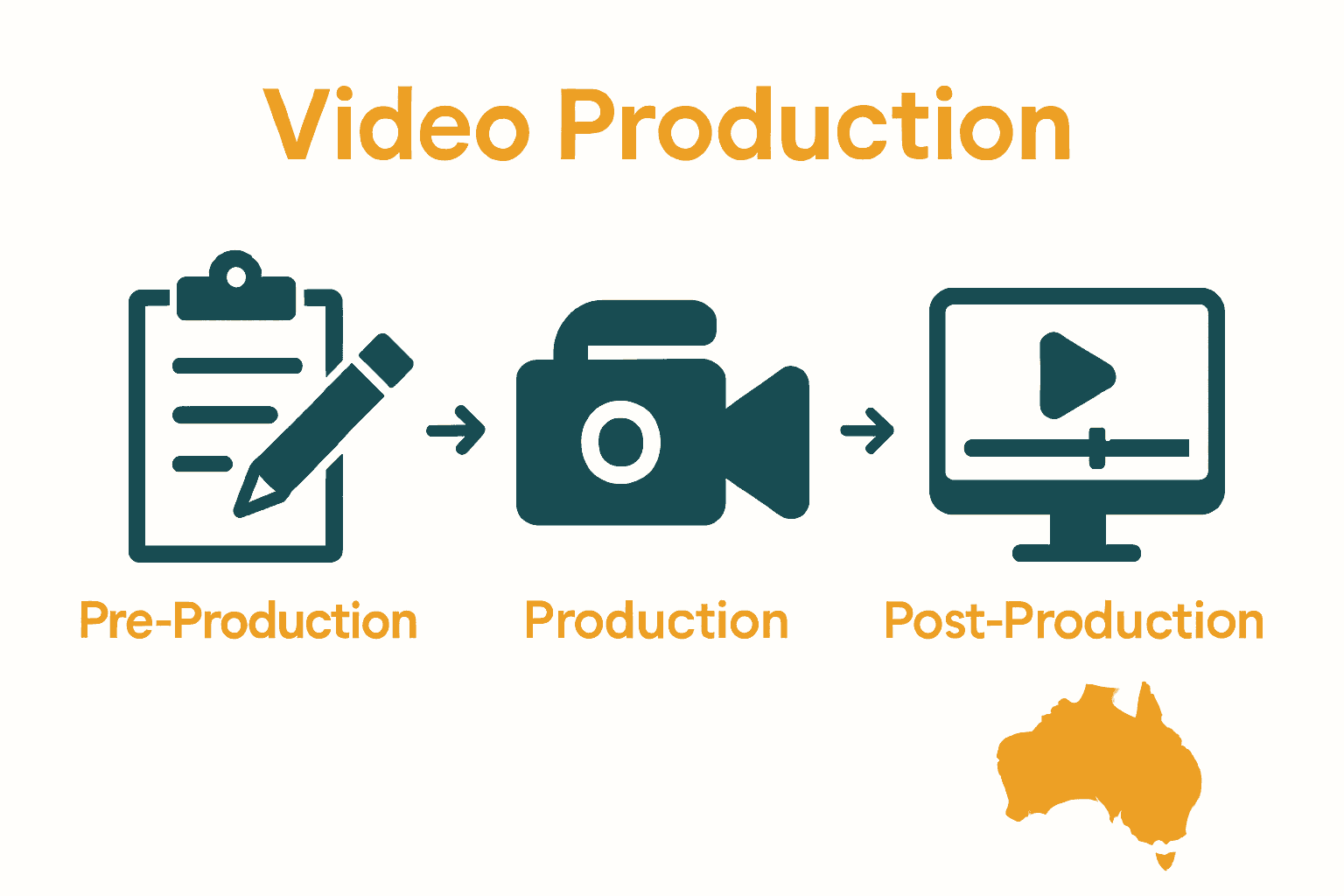What Is Video Production? Complete Guide for Australia
- Eddie The Chef

- Nov 11
- 7 min read

More than 85 percent of businesses now use video content to reach new customers and build trust online. The process of creating high quality video spans from creative planning to detailed editing, with each step shaping how your message is received. Understanding the core ideas behind video production helps you stand out and connect with real people, whether you are promoting your brand or sharing your expertise.
Table of Contents
Key Takeaways
Point | Details |
Comprehensive Process | Video production integrates planning, filming, and editing to create impactful narratives that resonate with target audiences. |
Strategic Necessity for Businesses | High-quality video content is essential for regional Australian businesses to enhance marketing effectiveness and communicate their brand story authentically. |
Understanding Project Types | Familiarity with various video formats—like corporate, marketing, and educational—is crucial for effectively conveying messages and engaging audiences. |
Risk Mitigation | Proactive risk management, including budget controls and creative alignment, is vital to successfully navigate the financial and technical challenges of video production. |
Defining Video Production and Key Concepts
Video production is the comprehensive process of creating visual storytelling through moving images, transforming raw visual and audio content into compelling narratives that communicate messages effectively. According to The Art of Video Production, this craft goes beyond mere technical skills, encompassing critical communication processes and strategic audience understanding.
At its core, video production involves several interconnected stages that transform conceptual ideas into polished visual experiences. These stages typically include:
Pre-production: Planning, scripting, storyboarding, location scouting
Production: Actual filming, capturing live footage, recording audio
Post-production: Editing, sound mixing, adding graphics, color grading
Modern video production has been dramatically reshaped by digital technologies, which have democratized content creation and expanded creative possibilities. The University of Adelaide highlights how digital media has become transformative, enabling more interactive and dynamic storytelling approaches that connect audiences through sophisticated communication techniques.
For regional Australian businesses, understanding video production is no longer optional—it’s a strategic necessity. Whether you’re a local cafe in Gippsland or a professional service provider in Melbourne, high-quality video content can dramatically enhance your marketing effectiveness, helping you communicate your brand story with authenticity and impact. The key is moving beyond technical execution to create narratives that genuinely resonate with your target audience.
Types of Video Production Projects Explained
Video production encompasses a diverse range of project types, each serving unique communication and storytelling objectives. According to Vaia, video production techniques span multiple genres, utilizing visual storytelling, scripting, dialogue, and sound design to create compelling narratives that engage audiences.
Types of Video Production Projects can be broadly categorized into several key formats:
Corporate Videos: Promotional content, training materials, company profiles
Marketing Videos: Advertisements, product demonstrations, brand storytelling
Documentary: Informative narratives exploring real-world subjects and experiences
Instructional/Educational: Tutorials, online learning content, skill development videos
Event Coverage: Conferences, weddings, live performances, sports events
Short Films: Creative narrative storytelling, artistic expressions
Social Media Content: Quick, engaging clips designed for digital platforms
The University of Adelaide emphasizes that successful video production requires mastering practical skills across digital camera operation, video recording, and editing techniques. These skills enable creators to transform conceptual ideas into polished visual experiences that resonate with specific target audiences.
For regional Australian businesses, understanding these video production project types is crucial. Whether you’re a local tradesperson creating an instructional video, a winery producing a brand story, or a professional service developing corporate content, each format offers unique opportunities to communicate your message effectively. The right video production approach can help you connect with your audience, showcase your expertise, and stand out in a competitive market.

Key Stages in the Video Production Process
Video production is a complex, multi-stage process that transforms creative concepts into compelling visual narratives. The University of Sydney highlights the critical importance of understanding both practical skills and theoretical foundations in creating effective video content, emphasizing that successful production requires meticulous planning and technical expertise.
The Video Production Process typically involves three fundamental stages:
Pre-Production: The strategic planning phase
Conceptualizing the video’s purpose and message
Developing detailed scripts and storyboards
Scouting locations
Casting talent
Creating production schedules
Budget planning
Production: The active filming stage
Setting up equipment
Capturing raw footage
Managing lighting and sound recording
Directing talent
Ensuring technical quality of visual and audio elements
Post-Production: The creative refinement phase
Video editing
Sound mixing
Adding graphics and visual effects
Color grading
Final review and client approval
Victoria University emphasizes that these stages are not merely technical steps, but creative processes that require innovative thinking and an understanding of how different design disciplines interact and evolve.
For regional Australian businesses, mastering these video production stages is crucial. Whether you’re a local cafe creating a promotional video, a trades business producing an instructional guide, or a professional service developing a corporate narrative, understanding this process ensures your video effectively communicates your message, engages your target audience, and represents your brand with professional quality.

Real-World Video Production Uses for Business
Video production has evolved from a specialized skill to an essential communication strategy for businesses across diverse industries. Conceptavision emphasizes that effective video production is about more than technical prowess—it’s about communicating powerful messages that connect with audiences and drive business objectives.
Key Business Applications of Video Production include:
Marketing and Promotional Content
Corporate brand storytelling
Product demonstrations
Customer testimonial videos
Service explanation videos
Training and Internal Communication
Staff onboarding materials
Safety instruction videos
Professional development resources
Process and procedure documentation
Customer Engagement
FAQ and support videos
Client case studies
Interactive explainer content
Behind-the-scenes glimpses of company culture
Vaia highlights how social media has dramatically transformed video production, making content more accessible and interactive. Short-form videos, user-generated content, and dynamic visual storytelling have become powerful tools for businesses to communicate authentically and engage directly with their target audiences.
For regional Australian businesses—from wineries in the Yarra Valley to trade services in Gippsland—video production offers a compelling way to showcase expertise, build trust, and differentiate themselves in competitive markets. Whether you’re a local cafe creating a mouth-watering menu showcase or a professional service explaining complex processes, strategic video content can transform how you connect with potential customers.
Costs, Risks, and What to Avoid in Video Production
Video production involves significant financial and creative investments that require careful strategic planning. Vaia emphasizes the critical importance of developing robust ethical guidelines and understanding potential risks before launching any video production project.
Common Cost and Risk Categories:
Financial Risks
Unexpected equipment expenses
Overrunning production budgets
Inefficient time management
Hidden post-production costs
Technical Risks
Poor audio quality
Inadequate lighting
Equipment failure
Insufficient backup strategies
Creative Risks
Misaligned messaging
Ineffective storytelling
Brand inconsistency
Audience disconnection
ArXiv Research highlights emerging challenges in video production, particularly around technological integration, noting the growing influence of artificial intelligence and the potential ethical dilemmas surrounding digital content creation. The research underscores the importance of maintaining creative authenticity while leveraging technological advancements.
For regional Australian businesses, mitigating these risks requires a proactive approach. This means investing in quality equipment, working with experienced professionals, developing clear creative briefs, and maintaining flexible production strategies. Whether you’re a local restaurant in Melbourne or a professional service in regional Victoria, understanding these potential pitfalls can help you create compelling video content that resonates with your audience while protecting your brand’s reputation and financial investment.
Take Your Video Production from Concept to Customer Connection
Understanding the complexities of video production can feel overwhelming for many regional Australian businesses. From planning clear messaging in pre-production to mastering post-production editing, every stage demands attention to detail and creative finesse. If you find yourself facing challenges like staying within budget, maintaining brand consistency, or crafting genuine stories that engage your local audience, you are not alone. The right video content has the power to transform how your business is seen and remembered.
At Marketing Recipes Australia, we combine over 30 years of experience with a unique kitchen-inspired approach to digital marketing. We do more than just produce videos—we help you create authentic narratives that resonate across social media, email campaigns, and your website. Our tailored strategies ensure your story connects effectively with your target market while avoiding common pitfalls such as technical missteps and inconsistent messaging.
Looking for expert assistance to make your video production journey effortless and effective?

Discover how our team can support your business through comprehensive video marketing and digital solutions. Visit Marketing Recipes Australia today to explore our full menu of services and start creating videos that truly speak to your customers. Take the next step now and turn your ideas into powerful stories that boost your brand presence and inspire action.
Frequently Asked Questions
What are the main stages of video production?
Video production consists of three main stages: pre-production (planning and scripting), production (filming and capturing footage), and post-production (editing and refining the final product).
How can video production benefit my business?
Video production can enhance marketing effectiveness, improve brand storytelling, engage customers, provide training materials, and showcase your services in a compelling way, ultimately driving business objectives.
What types of video production projects exist?
Types of video production projects include corporate videos, marketing videos, documentaries, instructional content, event coverage, short films, and social media content, each serving unique communication goals.
What are some common risks involved in video production?
Common risks include financial risks (unexpected expenses), technical risks (poor audio or lighting), and creative risks (misaligned messaging and ineffective storytelling). Proactively managing these can help ensure successful video projects.
Recommended
Comments